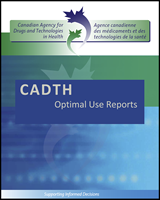Except where otherwise noted, this work is distributed under the terms of a Creative Commons Attribution-NonCommercial-NoDerivatives 4.0 International licence (CC BY-NC-ND), a copy of which is available at http://creativecommons.org/licenses/by-nc-nd/4.0/
NCBI Bookshelf. A service of the National Library of Medicine, National Institutes of Health.
Atypical Antipsychotics for Schizophrenia: Combination Therapy and High Doses — Project Protocol [Internet]. Ottawa (ON): Canadian Agency for Drugs and Technologies in Health; 2011 Aug. (CADTH Optimal Use Report, No. 1.1.)

Atypical Antipsychotics for Schizophrenia: Combination Therapy and High Doses — Project Protocol [Internet].
Show detailsCAC and ACP have identified atypical antipsychotics (AAPs) for schizophrenia — specifically high-dose and combination therapy — as being a priority topic for optimal practice initiatives, based on the following criteria:
- large deviations from optimal utilization (overuse or underuse)
- size of patient populations
- impact on health outcomes and cost-effectiveness
- benefit to multiple jurisdictions
- measurable outcomes
- potential to effect change in prescribing and use.
2.1. Schizophrenia
Schizophrenia is a mental illness that requires lifelong treatment.1 It is associated with symptoms that include hallucinations, delusions, cognitive impairment, disorganized thoughts, social withdrawal, and amotivation.2 Its worldwide prevalence is 0.5% to 1.5%;3 in Canada, it affects about 1% of the population2 or 234,000 people (2004 data).4 Schizophrenia is a chronic or recurrent illness and patients are at an increased risk for numerous other medical illnesses, suicide, substance abuse, homelessness, and unemployment.5 Diagnostic criteria for schizophrenia are currently based on the latest revisions of either the World Health Organization International Statistical Classification of Diseases and Related Health Problems (ICD-10) or the American Psychiatric Association Diagnostic and Statistical Manual of Mental Disorders (DSM-IV).3
The total financial burden of schizophrenia in Canada was estimated to be C$6.85 billion in 2004.6 The annual direct health care and non-health costs were estimated at C$2.02 billion (2004 dollars); acute (23%) and non-acute (38%) hospital care accounted for the majority of these costs.6
2.1.1. Management of schizophrenia
Antipsychotic medications form the cornerstone of treatment for schizophrenia,2 as they target the characteristic symptoms of the disease.3 These symptoms can be positive or negative in nature3 whereby positive symptoms reflect a distortion or an excess of normal functions and negative symptoms reflect a loss or restriction of normal function.7 The underlying principles in place for the administration of pharmacotherapy include the individualization of medication (including patient preferences), simple medication regimens, appropriate dosing, attention to side-effect profiles, regular evaluation of responses in general (including adverse events),5 and short- and long-term clinical efficacy, safety, and tolerability.1
Although there have been important developments in this area over the last 40 years, about one-third of persons with schizophrenia have a poor response to antipsychotic medications.8 Surveys of prescribing practices in the United Kingdom showed that the use of doses higher than the ones usually recommended is commonly encountered, either when antipsychotic agents are used alone or in combination with another antipsychotic medication.8 Also, although combination therapy with two antipsychotic agents is not recommended in current clinical management guidelines,5 with the exception of combination therapy with clozapine,8 it appears this practice is not uncommon.8,9 Overall prevalence rates of antipsychotic polypharmacy range from 4% to 58%,9 and rates of up to 69%10 have been reported depending on treatment setting and patient population. Data from British Columbia indicate that the rate of antipsychotic polypharmacy increased between 1996 when an estimated 28% of patients discharged from hospital were on polypharmacy, compared with 45% in 2000. For patients using clozapine, the rate of polypharmacy increased from 22% in 1996 to 53% in 2000.10 Two longitudinal studies from the United States reported that 9.5% to 22.0% of patients with schizophrenia received two antipsychotic agents concurrently.11,12 The proportion of patients treated with more than one AAP increased from 3.3% in 1999 to 13.7% in 2004.11 Reasons identified for this increasing prevalence include the use of pro re nata or take-as-needed medication, the gradual switch (bridging) from one antipsychotic drug (APD) to another one, as well as the combination of two antipsychotic medications to achieve greater therapeutic response when there has been an unsatisfactory response to a single APD.8
2.1.2. Technology description — Atypical antipsychotics
Most existing antipsychotic therapies fall into one of two classes. The typical antipsychotics (TAPs), also known as conventional antipsychotics or neuroleptics, are of the first-generation antipsychotic class. The atypical antipsychotics (AAPs) are of the second-generation antipsychotic class. Both classes are accepted by clinicians to be equally effective in the treatment of positive symptoms. AAPs appear to be more effective in the treatment of negative symptoms.1
There are currently seven AAPs available in Canada: aripiprazole, clozapine, olanzapine, paliperidone, quetiapine, risperidone, and ziprasidone. Also, two other AAPs (asenapine, Iloperidone) were recently approved in the United States. Since these new AAPs may eventually be available in Canada, asenapine and Iloperidone were included in the list of interventions considered for this project (Table 1).
Table 1
List of Atypical Antipsychotics Available in Canada and the United States.
- ISSUE - Atypical Antipsychotics for Schizophrenia: Combination Therapy and High ...ISSUE - Atypical Antipsychotics for Schizophrenia: Combination Therapy and High Doses — Project Protocol
Your browsing activity is empty.
Activity recording is turned off.
See more...